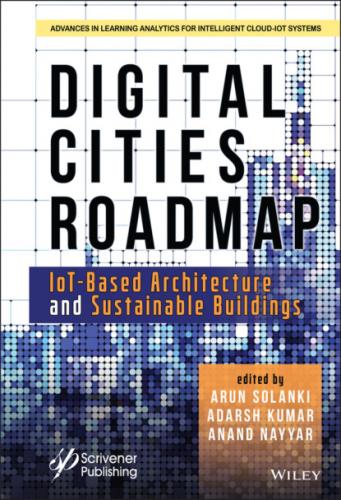Chapter 12, “Smart Health Monitoring for Elder Care in Indoor Environments,” discusses the various technologies that are being used by researchers to measure indoor environmental quality, human health and well-being along with case studies and real-life examples. Technology plays a crucial role in supporting the self-sufficient living of the elderly and their caregivers. However, the environmental quality of the spaces they reside in affects their health. Real-world case studies and their results are discussed in subsequent sections. Finally, available tools and research to aid readers delve further into this vital application area are discussed. Chapter 13, “A Comprehensive Study of IoT Security Risks in Building a Secure Smart City,” presents a holistic review of ML/DL algorithms that can be deployed to improve security. The IoT is capable of assimilating a variety of heterogeneous end systems by facilitating seamless access and communication among an expansive range of devices, people and their environment, making it the key feature in developing the idea of smart cities. This chapter delineates the challenges related to the technology’s implementation and standardization. It briefly overviews existing IoT architectures and enabling technologies, and also explores the prospects of ML/DL methodologies that can be implemented on the IoT platform to maintain an admissible level of services, security and privacy issues, with the aim of enhancing the overall experience of smart cities.
Chapter 14, “Role of Smart Buildings in Smart City: Components, Technologies, Indicators, Challenges, and Future Research Opportunities,” presents various indicators, technologies, components, and features of smart buildings in any smart city. General architectures are subsequently discussed along with the various supporting technologies and requirements of smart buildings for smart cities. The chapter ends with a discussion of the different challenges followed by future research opportunities in the domain of smart buildings in a smart city. Chapter 15, “Effects of Green Buildings on the Environment,” discusses concerns related to rapidly increasing environmental and sustainability issues like urbanization, climate change, loss of biodiversity and degradation of resources, which highlight the need for advancements in housing. Green building is the theory, science and styling of buildings planned and constructed in accordance with a minimum impact on the surroundings by reducing utilization of water, energy, and disturbances in the surrounding environment in which the building is located. This contribution is an attempt to appraise the value of green buildings compared to standard buildings. An attempt is also made to illustrate the available good practices regarding green structures in India.
The information provided in this book will be an incentive to the researchers, academicians and industry professionals interested in IoT-based architecture and sustainable buildings. The book also provides a platform to exchange knowledge in the field of energy efficiency and various tools and methods used to develop green technologies for construction in smart cities.
We would like to express our sincere gratitude to the contributors to the book, who supported us with the contribution of their valuable work and dedication to make this book a resounding success. Last but not the least, we thank Scrivener Publishing and associated production editors for handling the project and making this book a reality.
The Editors
January 2021
1
The Use of Machine Learning for Sustainable and Resilient Buildings
Kuldeep Singh Kaswan 1 * and Jagjit Singh Dhatterwal 2
1 School of Computing Science and Engineering, Galgotias University, Greater Noida, India
2 Department of Computer Science & Applications, PDM University, Bahadurgarh, India
Abstract
The use of Artificial Intelligence to ensure that intelligent and resilient buildings are sustainably developed. The intelligence displayed in buildings by electronic devices and software operated systems is artificial intelligence which perceives the building environment and takes actions aimed at optimizing output in a given context or constraint. A complex, sensitive infrastructure that ensures efficient, cost-effective and environmentally acceptable conditions for every occupant by constantly communicating with its four basic elements: locations (components, frameworks, facilities); processes (automation, control systems), staff (services, users) and management (maintaining, performance) and processes (controlling, systems); and they separate current technologies into two major groups, occupantcentered and energy-centered facilities. The first level approaches that use ML for occupant dimensions, including (1) occupancy and identity estimations, (2) behavior recognition and (3) choice and enforcement estimates. The approach in the second-class category used ML to approximate energy or device-related aspects. It is divided into three categories, (1) estimating the energy profiling and demand, (2) profiling and detection of faults of devices, and (3) sensor inferiority. In this chapter, we focus on guided study, unrestricted learning and improving learning. The main variants, implications of specific parameter choices are explored and we generate standard algorithms. Finally, discuss some of the challenges and opportunities in the built environment to apply machine learning.
Keywords: Machine learning, big data analytics, Internet of Things, smart building, resilient building, sustainable building
1.1 Introduction of ML Sustainable Resilient Building
The hyperconnectivity generated by IoT will enhance the assurance of Smart Sustainable Resilient Building (SSRB) as all basic construction facilities and goods from your home electronics to your plant vessels have now been connected [1–5]. Nevertheless, this hyperconnectivity could hinder the control of SSRBs at the same time. In particular, massive quantities of streaming data are required from SSRB and its residents. The management of large data streams is becoming more and more relevant with ML, testing, compaction, learning and filtration technologies. In order to obtain a greater interpretation of human beings than their environment computers, the amount of sensory data obtained by sensors and devices needs to be processed by algorithms, converted into details and derived expertise [6–8]. This awareness can also contribute, and most significantly, innovative goods and services that change our lives drastically. For starters, smart meter
